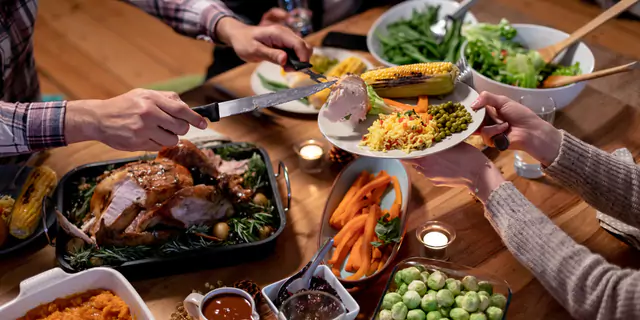10 Healthy Tips for Thanksgiving Day

Key Takeways
The holidays can be intimidating for anyone who struggles with maintaining healthy blood glucose levels. Not only are the foods traditionally prepared for Thanksgiving extremely rich and carb-heavy, but the average meal contains 3,000 calories.
Yes, you read that right! That's significantly more than most people's daily average in just one sitting. All of this, combined with the stress the holidays bring, can leave you feeling a little overwhelmed today.
It may sound like an impossible task to combat glucose spikes around this time of year. After all, how can you accept all the invitations to family feasts, indulge in the rich foods, and get the most out of your holiday dinner without sabotaging your glucose levels?
Don't miss out on the fun by depriving yourself of the traditional foods this Thanksgiving, but do celebrate smartly. Learn how to plan and plate your meal to optimize your health, and then go through this guide for some quick reminders, tips and tricks to help you through the day.
1) Start the Day Right

Start your day right! When you’re breaking your fast, do so in a way that prevents a hunger surge and sugar cravings later in the day. You may think it’s a good idea to save your appetite for the turkey, stuffing, and sides, but there's another way!
Consider eating something before the Thanksgiving meal instead of saving your appetite for just that. Focusing on breaking your fast with protein rather than with a large, calorie-laden Thanksgiving feast can help blunt a glucose spike during the celebratory meal.
2) Remember to Snack Smartly

You may feel like you need to steer clear of all the grazing options often laid out before dinner is served. Some appetizers can ruin your appetite and mess with a healthy diet, but not all appetizers do that. It may be a better idea to start the meal on appetizers of vegetables or nuts if those options are available.
A good rule of thumb is to limit processed meats, bread, and refined carbohydrates to help buffer your body for any carb or sugar-heavy foods in the meal to come. If you’re hosting, add some snacks that won’t raise your blood sugar to the appetizer table this year.
When in doubt, stick to a small plate of whole-food appetizers and avoid grazing mindlessly if possible.
3) Help Yourself Stay Hydrated

Staying well-hydrated is always essential, but on a day like Thanksgiving, even more so. Avoid sodas, beer, and sweet cocktails and opt for some flavored water instead. Try to keep your alcohol consumption to a minimum, alternating each drink with a glass of water. Alcohol can affect your blood sugar levels for up to 12 hours after you have a drink.
If you indulge, stick to clear spirits like vodka or tequila, skip the fruity mixers for seltzer, and add some citrus or mint for a bit of a flavor boost. This will keep the calories and sugar to a minimum. Drinking enough water will also help you stay full so that you don't overeat.
4) Stay Active

Activity before and after eating a meal goes a long way. By taking a short walk, you can lower blood sugar spikes and aid digestion. It doesn't have to be a solo activity either. A walk can be a nice way to continue a conversation with family or friends that you want to catch up with.
Make it a new family tradition! Try to fit in a workout before going to your host's home or before your guests arrive. Not only will a half-hour of vigorous exercise help control glucose levels, but it may help you have a healthier mindset and attitude towards food throughout the day.
5) Contribute to the Feast

Not only will contributing a dish to the table make your host appreciate you, but this is an ideal opportunity to add something healthy to the meal. Not sure what you can make in the few hours you have before the celebratory meal?
Prepare something simple, like a seasonal salad packed with nutrients, or this quick Lentil, Grape and Orange Salad! You can reduce your caloric and carb intake during dinner by providing yourself with an alternative or a healthy side to complement the conventional dishes.
Find the right Nutrisense programto turn insight into progress.
6) Be a Picky Eater

Are there foods you love that you only have at Thanksgiving, and others you find less appealing (yes, we’re talking about the divisive cranberry sauce!)? Fill your plate with small portions of your favorite foods, and leave everything you don’t love behind. This will help you feel satisfied and prevent overeating.
7) Say No Without Feeling Guilty

On a holiday like Thanksgiving, family and friends can often encourage you to have 'just another bite' even after you're full. Maybe your mother made a dish she wants you to eat more of, or you haven't tried every dish at the table yet. Whatever the case, remember that you can politely decline any pressure to eat more once you feel full.
For example, say something like, "Thanks for offering! That looks delicious. I am really full right now, but I'd love to take some for the road if that's okay!" When in doubt, it's always a good idea to focus on what your body is saying so you can recognize the signs of satiety and avoid overeating.
8) Slow Down and Enjoy the Moment

Eating slowly and chewing your food thoroughly can significantly help regulate your actual hunger level. When you eat too quickly, your body doesn't register how full you are. Chewing thoroughly and eating slowly will give your brain time to catch up with your stomach.
In addition to the health benefits of slowing down, you might find that you are enjoying your food more too. Savor every moment and every bite. You're probably spending Thanksgiving with loved ones, so remember to talk, reconnect and share stories instead of focusing solely on the meal in front of you.
9) Try the Small Plate Trick

If you can, use a small plate for your food. This will make you feel like you're eating more when you load up your plate. If there are only large plates, keep your food separate instead of stacking everything on top of other foods as we are wont to do around buffet-style meals.
This will help give you a better perspective on just how much you're eating. If you're still hungry after you finish, you can go get more! And if you do want seconds, wait a couple of minutes after you finish eating to make sure that you really are still hungry. Remember that your brain needs time to process what you've put in your stomach.
10) Our Most Important Tip: Enjoy Yourself

It can be easy to get swept up in the stress of staying healthy during the holiday season. What's on your plate, how will it influence your health, what about all the progress you've made so far? Stress can ruin your health too, and a little celebration can be good for you!
Besides, there's no one-size-fits-all with diets, and even foods you think may be terrible for you can surprise you when you eat them in moderation. So, remember to relax and enjoy the holidays. A little planning and some good habits surrounding food prioritization and physical activity can go a long way.
Go Beyond Glucose Data with Nutrisense
Your glucose can significantly impact how your body feels and functions. That’s why stable levels are an important factor in supporting overall wellbeing. But viewing glucose isn't enough. Nutrisense, you’ll be able to learn how to use your body's data to make informed lifestyle choices that support healthy living.
One-to-one coaching
Sign up to access insurance-covered video calls to work with a glucose expert: a personal registered dietitian or certified nutritionist who will help tailor your lifestyle and diet to your goals.
Monitor and measure what matters
With the Nutrisense CGM Program, you can monitor your glucose with health tech like glucose biosensors and continuous glucose monitor (CGM)s, and analyze the trends over time with the Nutrisense App. This will help you make the most informed choices about the foods you consume and their impact on your health.
Find your best fit
Ready to take the first step? Start with our quiz to find the right Nutrisense program to help you take control.

Kara Collier is a registered dietitian nutritionist and certified nutrition support clinician who is passionate about reshaping how we approach prevention, behavior change, and metabolic health. A Forbes 30 Under 30 honoree, she’s helped over 150,000 people improve their metabolic health using tools like continuous glucose monitors and behavior-focused nutrition strategies. Kara has been featured by Forbes, UC Berkeley, and HLTH, and has appeared on top podcasts like Mind Pump and The Genius Life.




.jpeg)